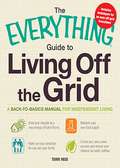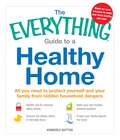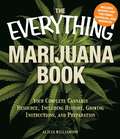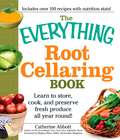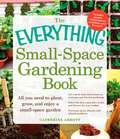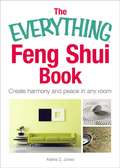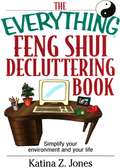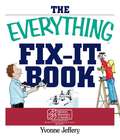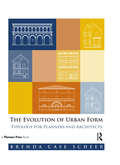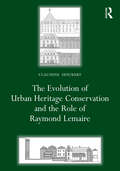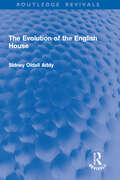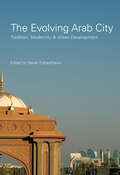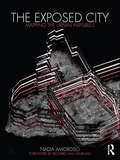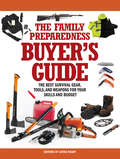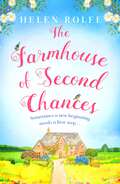- Table View
- List View
The Everything Guide to Living Off the Grid
by Terri ReidDo you want to have electricity and hot water at any time, no matter what's going on outside your property?Do you want to have more control over the things you eat and how they are processed?Do you want your family safe from the worries of a bad economy and crime?If you answered "yes" to these questions, then living off the grid may be for you. Although living off the grid takes some hard work, the benefits make it all worthwhile. This practical guide gives you all the information you'll need to move off the grid, including how to:Grow your own produceRaise, hunt, and process your meatEliminate existing debt to cut off financial tiesBuild a sustainable home from scratch Harvest and reuse waterCreate your own sources of energyWhether you want to live an eco-friendly life or just want to incorporate a few key aspects into your existing day-to-day, this guide is your comprehensive introduction to homestead sustainability.
The Everything Guide to Living Off the Grid: A back-to-basics manual for independent living
by Terri ReidDo you want to have electricity and hot water at any time, no matter what's going on outside your property? Do you want to have more control over the things you eat and how they are processed? Do you want your family safe from the worries of a bad economy and crime?If you answered "yes" to these questions, then living off the grid may be for you. Although living off the grid takes some hard work, the benefits make it all worthwhile. This practical guide gives you all the information you'll need to move off the grid, including how to:Grow your own produceRaise, hunt, and process your meatEliminate existing debt to cut off financial tiesBuild a sustainable home from scratchHarvest and reuse waterCreate your own sources of energy Whether you want to live an eco-friendly life or just want to incorporate a few key aspects into your existing day-to-day, this guide is your comprehensive introduction to homestead sustainability.
The Everything Guide to a Healthy Home: All you need to protect yourself and your family from hidden household dangers (The Everything Books)
by Kimberly ButtonAccording to the U.S. Environmental Protection Agency, the air in our houses is up to five times more polluted than air outside--so it's clear that our homes have become fundamentally unhealthy places. But there is hope! With this guide, you'll learn the immediate changes that make your home--and your life--healthier and safer by neutralizing the toxins, radiation, and chemicals that threaten the average house.Inside you'll find:Instant-fix checklists that will immediately make your home, workplace, and school saferRoom-by-room explorations of the most common and avoidable threatsSpecial tips designed to protect vulnerable infants, children, and pets With detailed checklists that are ranked by the projected health impact of making the fix, you'll be able to make real, concrete improvements to the health of your home. Whether you make every change or just a targeted few, the decisive steps in this guide will result in a safer, more comfortable, and more livable home for you and your family.
The Everything Home Storage Solutions Book
by Iyna Bort CarusoPacked with creative advice on how to get the most out of your living space,The Everything Home Storage Solutions Bookcan help solve even the worst packrat's storage problems with such hints as: Tuck away kitchen tableware and cooking tools in hidden shelving and door racks Store bedroom clothing and toiletries in roll-a-ways, drawer dividers, and valet chairs Organize home office paperwork in desk caddies and expandable-and storable-shelves If you're one of the 87 percent of Americans who live in small to medium-sized homes, you know that good storage is critical to comfortable living. And with family life becoming busier than ever, clearing away clutter can save you hours of time each week. WithThe Everything Home Storage Solutions Book, you can transform your home into the efficient, organized, and attractive living environment you've always dreamed about!
The Everything Home Storage Solutions Book
by Iyna Bort CarusoPacked with creative advice on how to get the most out of your living space, The Everything Home Storage Solutions Book can help solve even the worst packrat's storage problems with such hints as: Tuck away kitchen tableware and cooking tools in hidden shelving and door racks Store bedroom clothing and toiletries in roll-a-ways, drawer dividers, and valet chairs Organize home office paperwork in desk caddies and expandable-and storable-shelves If you're one of the 87 percent of Americans who live in small to medium-sized homes, you know that good storage is critical to comfortable living. And with family life becoming busier than ever, clearing away clutter can save you hours of time each week. With The Everything Home Storage Solutions Book, you can transform your home into the efficient, organized, and attractive living environment you've always dreamed about!
The Everything Home Storage Solutions Book: Make the Most of Your Space With Hundreds of Creative Organizing Ideas
by Iyna Bort CarusoPacked with creative advice on how to get the most out of your living space, The Everything Home Storage Solutions Book can help solve even the worst packrat's storage problems with such hints as:Tuck away kitchen tableware and cooking tools in hidden shelving and door racksStore bedroom clothing and toiletries in roll-a-ways, drawer dividers, and valet chairsOrganize home office paperwork in desk caddies and expandable-and storable-shelvesIf you're one of the 87 percent of Americans who live in small to medium-sized homes, you know that good storage is critical to comfortable living. And with family life becoming busier than ever, clearing away clutter can save you hours of time each week. With The Everything Home Storage Solutions Book, you can transform your home into the efficient, organized, and attractive living environment you've always dreamed about!
The Everything Marijuana Book
by Alicia WilliamsonWhen someone wants to start growing cannabis, they may be filled with questions: Is it legal? Can it be done inside or outside? It is hard to grow? In this book, you'll find a clear, step-by-step manual to the world of marijuana. Longtime licensed Oregon-based medical-grower Alicia Williamson explains the entire process--from choosing seeds or clones to proper curing and storage of harvest. You'll also find:Information on the legality of growingTips on growing indoors, outdoors, and in containersTroubleshooting information for plants that just won't grow Recipes for medibles such as fruit rollups and chocolate lolliesGrowing cannabis can be challenging, yet rewarding. From the beginner just starting out to the experienced gardener wanting to improve quality and productivity, this is the complete guide to everything marijuana.
The Everything Marijuana Book: Your complete cannabis resource, including history, growing instructions, and preparation
by Alicia WilliamsonWhen someone wants to start growing cannabis, they may be filled with questions: Is it legal? Can it be done inside or outside? It is hard to grow? In this book, you'll find a clear, step-by-step manual to the world of marijuana. Longtime licensed Oregon-based medical-grower Alicia Williamson explains the entire process--from choosing seeds or clones to proper curing and storage of harvest. You'll also find:Information on the legality of growingTips on growing indoors, outdoors, and in containersTroubleshooting information for plants that just won't grow Recipes for medibles such as fruit rollups and chocolate lolliesGrowing cannabis can be challenging, yet rewarding. From the beginner just starting out to the experienced gardener wanting to improve quality and productivity, this is the complete guide to everything marijuana.
The Everything Organize Your Home Book (The Everything®)
by Jenny SchroedelAre you living in a cramped quarters with no space to breathe? Do you feel overwhelmed by all that clutter? Would you prefer to do it yourself than pay a professional organizer? Get ready to add order to your home—one room at a time! With The Everything Organize Your Home Book, 2nd Edition, you’ll learn how to: -Set up a home office anywhere -Maximize closet and shelf space -Discover alternative storage ideas -Sell what you no longer need or want -Combat kid and toy clutter -Organize the garage, attic, car, and outdoor areas This fully revised and updated second edition proves that you can live large in even the smallest of spaces—by making every square inch count!
The Everything Root Cellaring Book: Learn to store, cook, and preserve fresh produce all year round! (Everything® Series)
by Catherine AbbottThere's an old-fashioned solution to the problem of fresh produce going bad. Store fruits and veggies in a root cellar or other cold storage location! This book provides you with step-by-step plans on how to build a root cellar--or utilize the one you've got. Professional farmer Catherine Abbott teaches you:How to effectively organize your root cellarWhere to store fruits and vegetables in unconventional placesWhat the best fruits and vegetables are for storingWays to preserve, dry, and freeze a variety of foods to enjoy all winter longRecipes for fresh fruits, berries, veggies, and herbs to cook all year round Featuring illustrations for building root cellars as well as a full nutritional breakdown for all 150 recipes, you will love this comprehensive guide. Before long, you'll know how to provide yourself and your family with great nutritious foods all year long!
The Everything Small-Space Gardening Book
by Catherine AbbottVine-ripened tomatoes. Succulent squash. Plump cucumbers. Growing vegetables is a rewarding--and cost-effective--way to eat better for less. However, you might think you lack the space necessary to grow a functioning garden. With this guide, however, you'll learn how to maximize your space and grow delicious vegetables and herbs cheaply and efficiently, whether you have a small backyard or just a windowsill! The book includes expert information on: How to align plants for maximum compatibility and organic pest deterrence Building small-space necessities, including self-watering containers and vertical planters A variety of plans designed to maximize the amount of food generated at several specific price points Productive gardening can and should be a reality for you, regardless of the amount of land you own. This book has everything you need to grow fresh produce in any size space, at any time of year!
The Everything Small-Space Gardening Book
by Catherine AbbottVine-ripened tomatoes. Succulent squash. Plump cucumbers. Growing vegetables is a rewarding--and cost-effective--way to eat better for less. However, you might think you lack the space necessary to grow a functioning garden. With this guide, however, you'll learn how to maximize your space and grow delicious vegetables and herbs cheaply and efficiently, whether you have a small backyard or just a windowsill! The book includes expert information on:How to align plants for maximum compatibility and organic pest deterrenceBuilding small-space necessities, including self-watering containers and vertical plantersA variety of plans designed to maximize the amount of food generated at several specific price pointsProductive gardening can and should be a reality for you, regardless of the amount of land you own. This book has everything you need to grow fresh produce in any size space, at any time of year!
The Everything Small-Space Gardening Book
by Catherine AbbottVine-ripened tomatoes. Succulent squash. Plump cucumbers. Growing vegetables is a rewarding--and cost-effective--way to eat better for less. However, you might think you lack the space necessary to grow a functioning garden. With this guide, however, you'll learn how to maximize your space and grow delicious vegetables and herbs cheaply and efficiently, whether you have a small backyard or just a windowsill! The book includes expert information on:How to align plants for maximum compatibility and organic pest deterrenceBuilding small-space necessities, including self-watering containers and vertical plantersA variety of plans designed to maximize the amount of food generated at several specific price pointsProductive gardening can and should be a reality for you, regardless of the amount of land you own. This book has everything you need to grow fresh produce in any size space, at any time of year!
The Everything® Feng Shui Book: Create harmony and peace in any room
by Katina Z. JonesWhether readers are looking to redesign their home or office, feng shui's easy-to-follow steps can create a room filled with tranquility with little effort or expense. 8-page color insert. Two color with illustrations throughout.
The Everything® Feng Shui Decluttering Book
by Katina Z. JonesOvercrowded closets, bursting bureaus, and desks of disarray affect the environment and stifle people's physical, emotional, and spiritual well-being. This title shows readers how to organize their belongings, create space, and promote positive energy flow in their home or office using simple feng shui principles.
The Everything® Fix-It Book
by Yvonne JefferySpecially written for the mechanically challenged, "The Everything Fix-It Book is the ideal resource to help homeowners prepare for the unexpected.
The Everything® Marijuana Book
by Alicia WilliamsonWhen someone wants to start growing cannabis, they may be filled with questions: Is it legal? Can it be done inside or outside? It is hard to grow? In this book, you'll find a clear, step-by-step manual to the world of marijuana. Longtime licensed Oregon-based medical-grower Alicia Williamson explains the entire process--from choosing seeds or clones to proper curing and storage of harvest. You'll also find: Information on the legality of growing Tips on growing indoors, outdoors, and in containers Troubleshooting information for plants that just won't grow Recipes for medibles such as fruit rollups and chocolate lollies Growing cannabis can be challenging, yet rewarding. From the beginner just starting out to the experienced gardener wanting to improve quality and productivity, this is the complete guide toeverythingmarijuana.
The Evolution of Urban Form: Typology for Planners and Architects
by Brenda Case ScheerWhy are so many of our urban environments so resistant to change? The author tackles this question in her comprehensive guide for planners, designers, and students concerned with how cities take shape. This book provides a fundamental understanding of how physical environments are created, changed, and transformed through ordinary processes over time. Most of the built environment adheres to a few physical patterns, or types, that occur over and over. Planners and architects, consciously and unconsciously, refer to building types as they work through urban design problems and regulations. Suitable for professional planners, architects, urban designers, and students, This book includes practical examples of how typology is critical to analytical, design, and regulatory situations.
The Evolution of Urban Heritage Conservation and the Role of Raymond Lemaire (ISSN)
by Claudine HoubartThe 1960s and 1970s saw a marked change in the approach to built heritage conservation. From a focus on the preservation of individual buildings, attention turned to the conservation, regeneration, and reuse of entire historic districts. A key player in this process was the Belgian art and architecture historian Raymond Lemaire (1921–1997), yet beyond those in conservation circles few people know of his work and influence or even recognize his name.In this book, Claudine Houbart traces how the change came about and the role played by Lemaire. She describes his work and influence and in so doing provides a history of urban conservation over the last four decades of the twentieth century and beyond. The first chapter summarizes Lemaire’s background from his training during the Second World War and his work as a Monuments Man immediately after the war, to his role in the drafting of the Venice Charter and his appointment as Secretary General of ICOMOS (International Council on Monuments and Sites). The next chapter describes the rehabilitation of Great Beguinage in Louvain. Now a UNESCO World Heritage Site, the project was directed by Lemaire and is a perfect example of the restoration of an entire district. The following chapter provides case studies of his work in Brussels, demonstrating his methodology in action. The final chapter discusses the transposition of the model of the historic city to urban projects and summarizes Lemaire’s influence on heritage conservation today, particularly integrated conservation. His participation in drafting key conservation documents sponsored by the Council of Europe, UNESCO and ICOMOS, and his desire to revise the Venice Charter are discussed. The book’s conclusion reflects on what has gone before, ending aptly with Lemaire’s own words ‘the past, properly understood, is one of the references for judging the value of today and tomorrow’.
The Evolution of the English House (Routledge Revivals)
by Sidney Oldall AddyThe Evolution of the English House (1933) discusses the popular and native art in domestic English architecture, tracing the changes over the years. The focus is on plain wattled huts and combinations of dwelling-house and cattle-stall, as well as the great villas and picturesque timber houses of the wealthy. In this way the author establishes how the masses of the English people lived in past times.
The Evolving Arab City: Tradition, Modernity and Urban Development (Planning, History and Environment Series)
by Yasser ElsheshtawyToday cities of the Arab world are subject to many of the same problems as other world cities, yet too often they are ignored in studies of urbanisation. This collection reveals the contrasts and similarities between older, traditional Arab cities and the newer oil-stimulated cities of the Gulf in their search for development and a place in the world order. The eight cities which form the core of the book – Rabat, Amman, Beirut, Kuwait, Manama, Doha, Abu Dhabi and Riyadh – provide a unique insight into today’s Middle Eastern city. Winner of The International Planning History Society (IPHS) Book Prize.
The Exposed City: Mapping the Urban Invisibles
by Nadia AmorosoThere is a vast amount of information about a city which is invisible to the human eye – crime levels, transportation patterns, cell phone use and air quality to name just a few. If a city was able to be defined by these characteristics, what form would it take? How could it be mapped? Nadia Amoroso tackles these questions by taking statistical urban data and exploring how they could be transformed into innovative new maps. The "unseen" elements of the city are examined in groundbreaking images throughout the book, which are complemented by interviews with Winy Maas and James Corner, comments by Richard Saul Wurman, and sections by the SENSEable City Lab group and Mark Aubin, co-founder of Google Earth.
The Exquisite Book of Paper Flower Transformations: Playing with Size, Shape, and Color to Create Spectacular Paper Arrangements
by Livia Cetti&“Equips crafters with the skills for creating individual flowers and larger arrangements while providing a delightful overview on the basics of botany.&” —Publishers Weekly In The Exquisite Book of Paper Flower Transformations, artist Livia Cetti ups the ante with a host of grander and more intricate flowers and projects—more blooms, more petals, stronger stems, and bigger, bolder arrangements! Cetti will teach you how to play with size, shape, color, and texture to create twenty-five vibrant single stems in a variety of natural shapes—globes, spikes, bells, saucers, rectangles, cones, and arcs—including hydrangeas, coral charm peonies, honeysuckles, and paperwhites. Then, you&’ll use these elemental shapes to build the 15 bright, abundant arrangements, including bold wreaths, bountiful bouquets, fantastical gilded wall art, and blooming garlands. Introducing new, never-before-seen techniques for dyeing paper and creating moldable leaves and petals, this gorgeous guide is perfect for crafters of all skill levels interested in making realistic and unique home decor, gifts, accessories, and entertaining essentials. &“Unlike fresh-cut flowers, paper blooms last forever. And if you make them like floral stylist, crafter and creative director Livia Cetti, they might even be mistaken for the real thing. One of the top paper-flower artists in the U.S.&” —House & Home
The Family Preparedness Buyer's Guide: The Best Survival Gear, Tools, and Weapons for Your Skills and Budget
by Living Ready Magazine EditorsThe essential guide to survival plan essentials! The key to being prepared is to have the things you need ahead of time--before an emergency happens. During these uncertain times, there is no such thing as being over prepared. With the huge range of potential disasters to prepare for, it can be overwhelming trying to decide which items are best to include in your survival plans. The Family Preparedness Buyer's Guide is an all-in-one guide to essential equipment that meets all basic survival needs. Applying this information to your survival plans will ensure your loved ones will be provided with adequate shelter, water, food and then some in a variety of emergency situations. Inside you'll find: Chapters arranged by survival category--survival kits; emergency shelter, fire and clothing; lighting and power sources; hydration and water purification; emergency food and cooking gear; multipurpose tools, first aid and hygiene; survival knives and cutting tools; communication and navigation tools; and survival guns. Lists of specifications for various disaster products so you can compare across brands and models and select the gear that is right for you Detailed feature articles for each gear type so you understand why the gear is essential before purchasing anything Reviews of specific gear and survival-related products When you are prepared, you're not just hoping for the best, you're planning for the best possible outcome no matter what life throws at you. Begin preparing today.
The Farmhouse of Second Chances: A gorgeously uplifting story of new beginnings!
by Helen Rolfe'A heartwarming story about family, forgiveness and the importance of kindness' FIONA HARPER on The Kindness Club on Mapleberry Lane'Comforting and uplifting, this book is a joy to read' MY WEEKLY'A heartwarming tale' WOMAN'S OWNHome is where the heart is... Joy has made a family for herself. She's turned her beautiful old farmhouse into a safe haven for anyone who is looking for a new beginning. She's always ready with a kind word, a nugget of advice and believes that anyone can change their life for the better, if they really want to. Libby has exchanged her high-flying job in New York for a break in the quiet Somerset countryside. She's soon drawn into Joy's world and into her family of waifs and strays - including Drew, whom Joy once helped get back on his feet. So when a secret from Joy's past threatens everything, can the unlikely group come together to give Joy a second chance of her own? Curl up with this uplifting new story of second chances and finding where you belong, from the author of The Little Village Library, perfect for fans of Cathy Bramley and Ali McNamara!***Readers adore Helen's heartwarming storytelling'Enchanting... Employing all the warmth and charm of Maeve Binchy, and a special brand of kindness that she has made her own, Rolfe weaves together elements of mystery, romance, family relationships and the warmth of community in a story guaranteed to bring laughter, tears and miles of smiles' Lancashire Post'A warm, comforting tale of family and community which brims with kindness and love' Annie Lyons'A heartwarming story about family, forgiveness and the importance of kindness... If you're looking for a feelgood novel in these difficult times, this is definitely it!' Fiona Harper'A lovely community, full of friendship and love''I enjoyed every minute of this book and found it very hard to put down''Lovely, feel-good...filled with lots of love''Gave you all the emotions: suspense, happiness and excitement''Helen Rolfe's writing brought a smile to my face''Loved loved loved this fabulous book'
